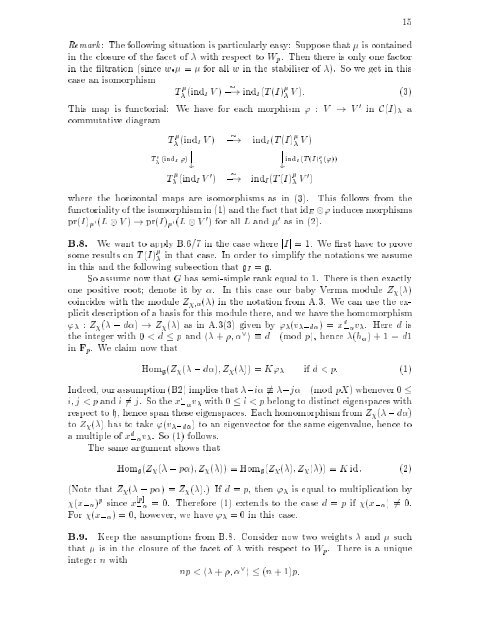subregular nilpotent representations of lie algebras in prime ...
subregular nilpotent representations of lie algebras in prime ...
subregular nilpotent representations of lie algebras in prime ...
Create successful ePaper yourself
Turn your PDF publications into a flip-book with our unique Google optimized e-Paper software.
Remark: The follow<strong>in</strong>g situation is particularly easy: Suppose that is conta<strong>in</strong>ed<br />
<strong>in</strong> the closure <strong>of</strong> the facet <strong>of</strong> with respect to Wp. Then there is only one factor<br />
<strong>in</strong> the ltration (s<strong>in</strong>ce w = for all w <strong>in</strong> the stabiliser <strong>of</strong> ). So we get <strong>in</strong> this<br />
case an isomorphism<br />
T (<strong>in</strong>dI V ) ,! <strong>in</strong>dI(T (I) V ): (3)<br />
This map is functorial: We have for each morphism ' : V ! V 0 <strong>in</strong> C(I) a<br />
commutative diagram<br />
T (<strong>in</strong>dI V ) ,! <strong>in</strong>dI(T (I) V )<br />
T (<strong>in</strong>dI ')<br />
?<br />
?y<br />
?<br />
?y<strong>in</strong>dI(T (I) ('))<br />
T (<strong>in</strong>dI V 0 ) ,! <strong>in</strong>dI(T (I) V 0 )<br />
where the horizontal maps are isomorphisms as <strong>in</strong> (3). This follows from the<br />
functoriality <strong>of</strong> the isomorphism <strong>in</strong> (1) and the fact that idE ' <strong>in</strong>duces morphisms<br />
pr(I) 0(L V ) ! pr(I) 0(L V 0 ) for all L and 0 as <strong>in</strong> (2).<br />
B.8. We want to apply B.6/7 <strong>in</strong> the case where jIj =1. We rsthave toprove<br />
some results on T (I) <strong>in</strong> that case. In order to simplify the notations we assume<br />
<strong>in</strong> this and the follow<strong>in</strong>g subsection that gI = g.<br />
So assume now that G has semi-simple rank equal to 1. There is then exactly<br />
one positive root; denote it by . In this case our baby Verma module Z ( )<br />
co<strong>in</strong>cides with the module Z ; ( ) <strong>in</strong> the notation from A.3. We can use the explicit<br />
description <strong>of</strong> a basis for this module there, and we have the homomorphism<br />
' : Z ( , d ) ! Z ( ) as <strong>in</strong> A.3(3) given by ' (v ,d )=x d , v . Here d is<br />
the <strong>in</strong>teger with 0

















